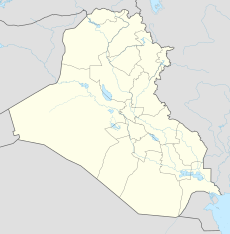33°51′27″N 43°49′47″E / 33.85750°N 43.82972°E
Muthana State Establishment or Muthanna (Arabic: منشأة المثنى العامة) (also known for its code-name Project 922 and cover name State Enterprise for Pesticide Production (SEPP)) was Iraq's main chemical weapons research, development, and production facility. It is located in Saladin Governorate 40 km south west of Samarra, 140 km north west of Baghdad. This mega facility covering an area 100 km2, contained three main production areas.
The site operated continuously from 1983 to 1991, producing thousands of tons of precursors and chemical warfare agents, including mustard gas, sarin, tabun, and VX. The site was heavily bombed during the Gulf War. From 1992 to 1994 the UNSCOM Chemical Destruction Group operated at this site to eliminate remaining precursor materials, destroy production plants and equipment, and hydrolyse or burn remaining chemical warfare agents. Muthana was also the initial location for Iraq's biological weapons program (1985-1987).[1]
Foundation edit
Muthana State Establishment was built in the early 1980s under the guise of a pesticide production plant dubbed "The State Enterprise for Pesticide Production" or "SEPP" (its name changed later to Muthana State Establishment).
This Iraqi chemical weapon program was assisted by a wide variety of companies and governments.[2][3][4][5][6]
German companies helped Iraq to build Muthana facilities such as laboratories, an administrative building, bunkers in the early 1980s. Other German companies provided Iraq with 1,027 tons of precursors of mustard gas, sarin, tabun, and tear gasses in all. This work allowed Iraq to produce 150 tons of mustard agent and 60 tons of tabun in 1983 and 1984 respectively, continuing throughout the decade.
Production edit
Between 1981 and 1991, Muthana establishment produced over 3,857 tons of chemical weapons agents part of them has been used against Iranian forces and civilian Kurdish.[7]
Mustard edit
Production of mustard started at 10 tons of agent production in 1981 and increased around 80-100 tons per year until 1985 when the facility produced 350 tons. In 1987 Iraq produced almost 900 tons of mustard agents and 500 tons in 1988.
Tabun edit
Muthana facility produced between 60 and 80 tons of tabun annually between 1984 and 1986.
Sarin edit
In 1984 Muthana produced 5 tons of sarin. Production of sarin constantly increased. In 1987 and 1988 Muthana facility produced 209 and 394 tons of sarin, respectively.
VX edit
Muthana produced 2.5 tons of VX in 1988 before ending production due to the end of the Iran-Iraq War.[8]
Gulf War edit
Al Muthanna essentially ceased production in December 1990 and refocused resources on dispersing Chemical Weapons stockpiles and equipment for protection against the anticipated bombing campaigns, which started in January 1991. During the Gulf War, production laboratories and facilities were destroyed. In addition one storage bunker was destroyed because of secondary explosion, and two others bunkers were severely damaged.
Between 1991 and 2003 edit
Between 1992 and 1994 the Muthana site was the main collection and destruction site for chemical warfare agents, precursor chemicals, and chemical production equipment. Between 1992 and 1994, the UNSCOM destroyed 30,000 pieces of ordnance, 480,000 liters of chemical agents, and more than 2 million liters of chemical precursors. Eventually, most of the facilities at the complex were destroyed or sold for scrap.[9]
Munitions that had been considered unstable and too dangerous for destruction were sealed into barrels and buried in two sealed cruciform bunkers. When the bunkers damaged by coalition airstrikes collapsed, unaccounted Chemical Weapons equipment and munitions were concealed in the debris.
After their destruction in coalition airstrikes of February 1991, access to the buildings had been considered impossible due to safety considerations. Nevertheless, UNSCOM decided that it should make a major effort to excavate the site. From 24 February to 10 March 1996, UNSCOM 129B, an international team of 26 inspectors, excavated six sections of buildings at Muthanna and searched a number of other areas and buildings. During this mission, the team discovered and retrieved documents and computer discs. In addition, the team removed some 80 munitions and components, including 122 mm chemical artillery shells and 155 mm "binary" chemical artillery shells.[10]
References edit
- ^ "Muthanna / Samarra - Iraq Special Weapons Facilities". fas.org. Retrieved 2015-06-03.
- ^ "What Iraq Admitted About its Chemical Weapons Program". Archived from the original (GIF) on 2006-05-04. Retrieved 2006-04-28.
- ^ "Iraq's Purchases in the A-Bomb Supermarket" (PDF). The New York Times: E5. July 18, 1993. Archived from the original (PDF) on April 3, 2003. Retrieved 2006-04-28.
- ^ "Comprehensive Report of the Special Advisor to the DCI on Iraq's WMD, Chapter 4 - Nuclear". September 30, 2004. Archived from the original on June 13, 2007. Retrieved 2007-09-13.
- ^ "Comprehensive Report of the Special Advisor to the DCI on Iraq's WMD, Chapter 5 - Iraq's Chemical Warfare Program". September 30, 2004. Archived from the original on June 13, 2007. Retrieved 2007-09-13.
- ^ Tony Paterson (December 18, 2002). "Leaked Report Says German and US Firms Supplied Arms to Saddam". The Independent (UK). Archived from the original on May 27, 2013.
- ^ "Iraq's Chemical Warfare Program — Central Intelligence Agency". www.cia.gov. Archived from the original on June 13, 2007. Retrieved 2015-06-03.
- ^ "Al Muthanna Chemical Weapons Complex — Central Intelligence Agency". www.cia.gov. Archived from the original on June 13, 2007. Retrieved 2015-06-03.
- ^ "Al Muthanna Chemical Weapons Complex — Central Intelligence Agency". www.cia.gov. Archived from the original on June 13, 2007. Retrieved 2015-06-03.
- ^ "Muthanna / Samarra - Iraq Special Weapons Facilities". fas.org. Retrieved 2015-06-03.
